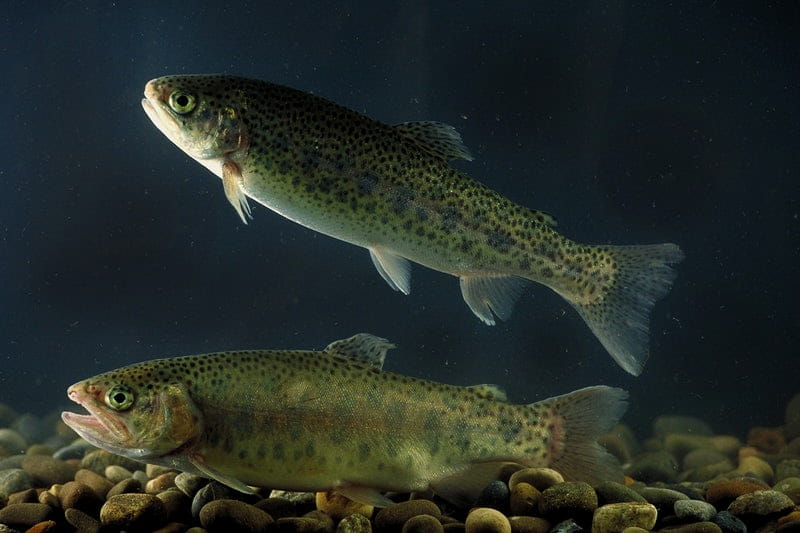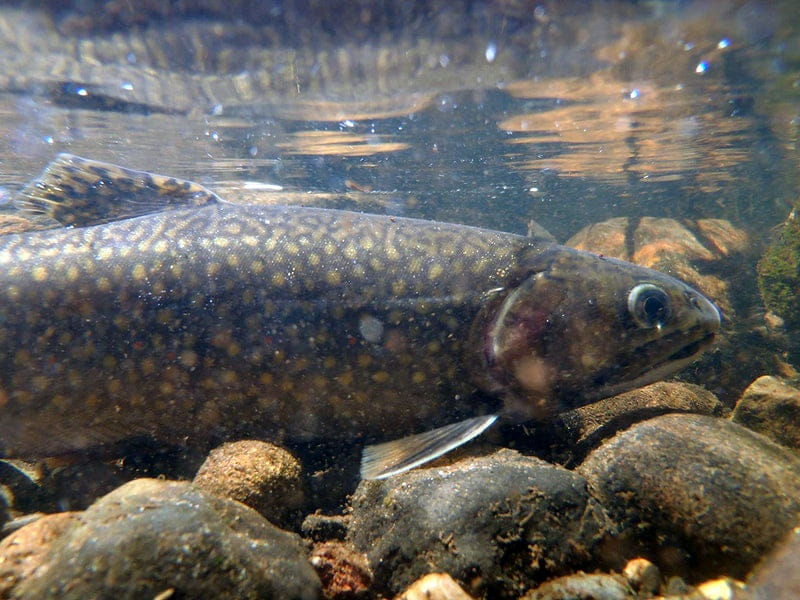Lake trout is rich in flavor, making it an excellent treat given by nature. If you want to catch this species, fly fishing will be the best technique.
This article will provide you with the most powerful tips for fly fishing for lake trout. Let’s check out the guide, grab your rod, and there you go!

Lake Trout Overview
The lake trout is a freshwater species found mainly in North America. You can also see it in Canada or the Great Lakes area.
Here is some basic information about this fish:
- Size: 24 to 36 inches
- Weight: 5 to 12 pounds
- Appearance: dark green/gray/olive brown body with spots, a white belly, and white-edged fins.
- Taste: pronounced fishy taste
You can check the appearance to distinguish the trout from other species in the lake. They are big enough to spot quickly.
Another way to point it out is to see how the trouts react on the fishing line.
These fish love fighting and are energetic. If you feel a huge tug on your line, it may be the lake trout biting it.
Best Place And Time For Fly Fishing For Lake Trout
When and where to fish lake trout? To answer this question, we will analyze the four most important factors.
Water temperature
Water temperature is the essential factor. In general, lake trout love the range of 55 to 60°F.
This temperature makes the fish feel comfortable, and its body metabolizes food easier and quicker. So, how to tell if the water temperature is ideal?
A thermometer or any type of temperature-reading tool can help you check it. Keep switching spots until you can locate the correct range.
Lake depth
The perfect time for fishing lake trout is either early in the morning or sunset. During this time, your prey often accesses the shoreline for food.
The timetable of this species is as follows:
- Morning: Lake trout swim on the shoals near the shoe.
- Mid-day and high sun: At noon, the fish move to deeper areas because they need water depth to protect themselves from the sun.
- Sunset: The fish return to the shoals to feed weed.
These fish often stay deeper during the scorching summertime as they search for the ideal feeding temperature.
They will move to the higher water during the fall, spring, and winter.

Weather
The wind affects your rod casting significantly. However, depending on where it blows while you are on the lake, the wind can either be pleasant or unpleasant for your trip.
When a storm is coming, your fishing may be terrific. The trout will attempt to take as much food as possible before the low-pressure system because they can sense an approaching problem.
If the storm is too big, things change. You will have a long, tiring, and slow day because your prey becomes lackluster.
They can’t see the lures and will move to deeper water to protect themselves against the storm.
Your experience can be worse because you have to endure the large fronts. The alarm clock may not work in that case.
As a result, check for the weather when planning your trip. Otherwise, the storms will turn from your buddy to your enemy.
Seasonalities
Like other organic habitats, lakes have their life cycles and repeat them through seasons.
Often, a lake turns over twice yearly, one in spring and one in fall. During this time, the lake will flip its water.
In the summer, the sun will heat the water, making its surface hot. However, the sunlight can’t reach the deep layers. Hence, the deepest water is the coldest one.
When the fall comes, the warmer layers cool and get denser. They sink to the bottom and lower the level rise, giving the seasonal turnover effect.
You will see the same thing when the frozen water melts in the spring and warms the extra layers.
Turnovers are not ideal for fishing. Instead, choose the first few weeks after the ice recedes from frozen water.
Trout are aggressive then, and big ones access the shores to feed after a long winter.
What Do You Need To Fly Fish For Lake Trout?
Knowing the ideal fishing time and place is enough for setting the schedule. However, you also need to pack up the right gear, which includes:
Rod
Anglers have different requirements for the rod. There are two main things to consider:
- Weight
Most people agree that you need somewhere between 5 and 10 weight range. However, avoid the 6-8 weight range while dry fly or nymph fishing.
You’ll need a fishing rod with a strong backbone if you’re casting large streamers and hefty sinking lines.
- Length
In addition, you should choose a rod that is around 9 feet in length. Experts will advise using a graphite fly rod in this situation because:
- You will have a highly durable rod.
- The rod is heavy enough to reach the water depths you need.
- You can easily grasp your rod while casting because it’s not too chunky.
Read also: Trout Fishing Without a Fly Rod (Solved!)
Reel
The right reel allows you to catch big trouts. You can choose machined or aluminum reels as they work well.
Instead, pay more attention to the drag system, the main defense against aggressive fish.
Lake trouts often pull away the lure and try to swim back to their homes.
They will become more panicked when staying close to the surface. So, once they pull, it’s hard to let them stop.
Scientists explain that trout find it difficult to breathe near the surface. The lack of oxygen makes them try to go deeper.
Find a smooth drag featuring a big arbor to deal with this problem. The big arbor reels can give you a fantastic backing capacity and a quick retrieval rate.
Disc Drag is a popular choice. Spring and Pawl may also suffice, but they can’t pull as powerful as the Disc Drag.
Line
You may choose a different line when you go fly fishing.
Please note that during the fall or spring, trout swim around shallower waterways. However, in the summer, they move to deeper waters.
If you’re fishing surface streamers or poppers, you only need short and quick sink ends when the fish come near the surface. Floating lines can be very beneficial if you fish dry flies and nymphs using weights.
Fly
Experienced anglers recommend the following three flies when fly fishing lake trout:
- Dry fly: These flies are perfect for fishing in shallow waters. They will help you lure rainbow trout closer to the surface and reel them in then.
- Nymph fly: YOu can drop nymph flies under the water surface. They can attract lake trout by mimicking their food.
- Streamer: These massive flies feature long pieces of materials that swing in the water. Hence, they establish a lifelike appearance that lures the lake trout easily.
How To Fly Fish For Lake Trout?
The key to fly fishing lake trout is the dropper rigs beneath a hopper pattern or an indicator. Determining the correct depth for your flies is your top priority.
You should hook the first fly onto a 9-foot leader just a few feet beneath your indicator. Trout feed deeper in colder water.
If your dropper rig has leeches or streamers, you should perform a strip retrieve to offer it mobility, just like any other streamer.
You need to add some motion to your nymph flies by slowing down the retrieve.
Otherwise, let your flies come loose and wait. In the end, the trout pod may circle back, and the indicator will vanish in the water.
Wrapping Up
Fly fishing can satisfy any angler. If you choose lake trout as your prey, your experience will improve significantly.
Before heading to the fishing spot, carefully check the time, place, weather, and essential gear. Then, you will have a productive fishing trip.
Do you find this post helpful? If you need more ideas for your next adventure, please comment below. We will get back to you soon. Thank you for reading!